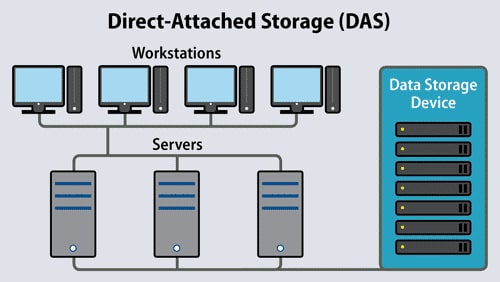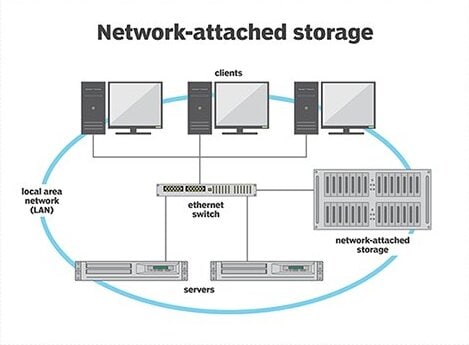
Choosing the ideal data storage solution can take time and effort. You must be aware of other alternatives to choose the one that best meets the data storage you need in the face of many possibilities. NAS and DAS servers are the two most popular data storage solutions. Reading this guide will help you decide what to choose as the differences between NAS and DAS storage devices are compared.
Part 1: Direct-Attached Storage (DAS) Overview
What Is DAS
DAS (Direct-Attached Storage) refers to a storage device that is entirely connected to a computer. DAS is not available to other computers unless they connect to it through the host computer because it is attached to just one computer or server.
The DAS enclosure will be a distinct adjacent cabinet containing the extra disk drives. Digital storage immediately connected to the host computer that will access it is known as direct-attached storage (DAS).
Direct-attached storage options include optical drives like CDs and DVDs, hard drives, solid-state drives (SSD), and tape storage.

How DAS Works
DAS (internal or external) does not need a network to connect to the host computer or server. A high-speed host bus adapter (HBA) can connect an internal storage device to a server or personal computer.
Each personal computer has at least one internal DAS drive, either a slower SSD or a more modern HDD connected via the SATA interface. Additionally, servers include internal storage that may be accessed through SATA or other quick interfaces like SCSI or SAS.
External hard drives and disk enclosures holding numerous drives are examples of external DAS. These are linked to workstations and servers through USB, eSATA, SAS, or SCSI.
The computer is plugged in to oversee and control DAS. Computers on a network must interact with the computer with which the DAS is connected rather than accessing the data directly.
Pros of DAS
- Cost-effective storage device: DAS is the least expensive option among the three storage types because it doesn't need a network or any network-related hardware, like SCSI cables and Fibre Channel switches.
- Simplified Administration: Because there are no complex protocols to manage, the setup and configuration are straightforward, requiring little to no administration training.
- Flexible Capacity: DAS enables hard drive addition without needing an expensive SAN switch that IT specialists can only manage. Users plug another drive into their computer or server as they would with additional memory sticks.
Cons of DAS
- The inability of a DAS system to be operated over a network: Only the DAS host computer has access to and control over data.
- Refrain from offering choices for data redundancy levels as their NAS counterparts: DAS's directly attached nature and lack of network connectivity make it unsuitable for offering storage connectivity to numerous users or devices. Additionally, the number of connections a host computer can use and the number of drives the DAS solution supports limit the expandability of DAS.
Part 2: Network-Attached Storage (NAS) Overview
What Is NAS
Network-attached storage (NAS) is a data storage device that connects to and is accessed via a network rather than directly to a computer. NAS devices include a processor and an operating system, allowing them to run applications and provide the intelligence required for files to be easily shared by authorized users.
It is a self-contained storage server connected to a local area network (LAN) or Wide Area Network (WAN). The network administrator can grant access to the data kept on the NAS system to all devices connected to the network. It has mobile NAS servers and network administration software, which enables multiple users to access the storage system.

How NAS Works
NAS programs integrate hardware and software with policies and procedures to enable network file sharing. Following these protocols allows any computer to access data from the NAS device as if they were stored on the system itself.
A NAS unit works continuously and appears as a shared network drive. You configure and manage it from a PC via a browser. You can access NAS via your Wi-Fi network or an internet browser when you are not at home.
Pros of NAS
- Enhanced Operation: NAS devices are simple to manage since they use common rules, guidelines, and file systems.
- Expandable Storage Capacity: NAS devices are highly flexible by including more drives or nodes as required. The main benefit of NAS storage is that you can scale up to a petabyte scale with virtually hundreds of NAS appliance nodes. Furthermore, because of its compact size, it saves space.
- Improved accessibility: NAS establishes a dedicated storage system that simplifies access to data for networked devices. Whether using a PC, Mac, or a variety of operating systems like Windows, Unix, or Mac OS, users can work together and share files from various locations.
Cons of NAS
- More administrator management is required than with DAS: NAS devices use their CPU, RAM, and so on. with few upgrade options. As a result, if the device experiences performance issues, upgrading the underlying hardware may be difficult.
- Network issues may cause issues: The device's performance is affected because NAS is network dependent. A slow network, for example, can harm a NAS solution. As a result, when incorporating NAS solutions, network speed and latency should be primary considerations.
Part 3: Differences Between NAS and DAS
The first section covers the overview of NAS and DAS drives. Now, what is the difference between NAS and DAS? Here is a more detailed explanation of their different features.
Video Tutorial on NAS vs DAS
For Windows XP/Vista/7/8/10/11
For macOS X 10.10 or later
NAS vs. DAS - Storage Capability
The primary difference between DAS and NAS servers is that DAS servers provide more localized storage. Thus, DAS drives do not provide the flexibility of file sharing and remote updating that NAS servers do. Regarding storage, NAS outperforms DAS because one can easily add another portable NAS storage device to the network as the data storage requirements grow.
NAS vs. DAS - Data Transferring Method
Networked storage systems (NAS) pool storage capacity and distribute it to application servers via a high-speed network. On the other hand, DAS connects directly to the servers, which means that connectivity and expandability are both limited by the number of expansion slots in the server.

NAS vs. DAS - Speed and Performance
The first difference between NAS and DAS is speed. DAS appears faster than NAS due to connections like USB and Thunderbolt, which allow for massive direct performance benchmarks of hundreds/megabytes per second (MB/s).
However, the NAS system is typically connected via a gigabit Ethernet network, and in its most basic configuration, it can only provide between 100 to 109 megabytes/sec. Although the NAS's single standard Ethernet connection can only provide speeds of more than 100 Mbytes/sec, this can be doubled or quadrupled by link aggregation, which is available on many low-cost NAS systems.
Through very reasonable expansion cards and adapters, the network interface can be extended from 1Gbe LAN/Ethernet to 2.5Gbe, 10Ge, and higher, allowing the NAS to execute several gigabytes per second and support concurrent use by numerous users.
As a result, NAS still moves at a far slower pace than DAS.
NAS vs. DAS - Price
DAS has a more diverse range of external drives and a lower overall cost when compared to similar NAS systems with similar terabytes of storage and scale. As a result, the cost of DAS storage is more affordable for home users.
However, in terms of value, NAS is the superior option. It is due to the features and functions available in NAS, which include dedicated backup tools, integrated software, manageable application GUI and web browser, and a large storage capacity compared to external DAS drives. NAS deployment is flexible and adaptable.
Furthermore, because most operating systems support mapped network drives, real-time synchronization software, and the local file system or the file manager, NAS servers are pricier than DAS servers.
NAS vs. DAS - Ease of Use
There is no doubt that DAS is more user-friendly than NAS. USB drives and RAID enclosures are almost completely plug-and-play when connected directly to a Windows PC or Mac system. The feature is extremely simple.
However, to create a semi-automated or fully automated backup strategy and easily share large files with remote users, the DAS solution necessitates using multiple third-party software or includes a third-party cloud platform integrated into the software environment. With NAS, you can share files safely, securely, and easily after the initial setup.
Part 4: NAS vs DAS - Comparison Chart
Let’s look at the comparison chart below to further understand the difference between NAS and DAS regarding some of their certain features.
Differences |
NAS |
DAS |
| Working method | Files are utilized for data backup and recovery. | Sectors are employed for data backups and recovery. |
| Main functions | Sharing and transmitting over a network. | Direct connection to devices with no network is required. |
| Type of Storage | Shared files | Sectors |
| Data transferring method | Ethernet, TCP/IP | IDE/SCSI |
| Speed | 20-50 ms | 5-10 ms |
| Price | More costly than DAS | More affordable than NAS |
| Ease of use | Moderate | Easy |
Part 5: NAS vs DAS: Use Cases
NAS Use Cases:
NAS is a viable solution for SMBs and other businesses that require an optimized, flexible, and network-based file-serving and sharing storage system. Businesses should consider a network-attached storage device to share files easily and affordably across the network and to keep a complicated system running. Several use cases include the following:
- File Sharing and Storage: NAS is the preferred option for any organization, regardless of size, that requires centralized file storage and sharing solutions. Users can use a single NAS device to combine multiple file servers, saving space and facilitating management. It also makes collaboration possible.
- Massive Data: Large amounts of unstructured data from IoT devices, video surveillance recordings, and other sources can be stored on NAS. It can handle intelligent data services, ETL (extract, transform, load) processes, analytics, and more because it is simple to scale.
DAS Use Cases:
DAS is ideal for small businesses and organizations that require a low-maintenance, dependable, and adaptable storage system that can quickly scale up to accommodate new users or growing data. These deployment scenarios permit the use of a DAS device:
- Small businesses or workgroups that only require the exchange of information locally have a fixed, non-growing budget and have little to no IT support.
- Industrial PCs: For personnel working in industrial environments which require inexpensive local storage with quick access.
Part 6: NAS or DAS: Which One Should You Choose?
Both NAS and DAS offer benefits and unique features. The best option will depend on your specific needs in terms of data storage volume, financial constraints, and backup and recovery requirements.
If you have a sizable budget, need large-capacity data storage, need to share data among others, and have a dedicated IT staff in charge of data management and maintenance. NAS is the ideal option for you. On the other hand, DAS is a good fit if you have a tight budget and little need for data sharing because it enables others to share data locally.
There is no one size fits all solution for data storage. What works for one might not work for another, and vice versa. Note these criteria before deciding what to use between NAS and DAS storage:
- Data quantity to process, store, and retain: How much information do you need to store? It ranges from a few terabytes to petabytes, depending on the sector and size of your company.
- Performance at various data lifecycle stages: What performance requirements do your workloads have? How many people will use it, from where (remote or internal), and how frequently, need to share, access, or collaborate on files?
- Scalability: Do you produce, process, and store huge amounts of data? How quickly does it expand? You require a data storage system that can scale smoothly and keep up with your data expansion.
- Data security elements: Immutability and air-gapping, file lockout, encryption, and more must be present in any data storage system you set up, as well as any backup and disaster recovery solution.
- Total Cost of Ownership (TCO): How much money do you have to spend? Analyzing and taking into account costs is necessary for all decisions.
- Human Resources: How many IT professionals are you prepared to hire and commit to your data storage infrastructure?
Among the leading top manufacturers of NAS servers are Dell Technologies, Synology, NetApp, Hewlett Packard Enterprise (HPE), Hitachi Vantara, NETGEAR, IBM, QNAP Systems, Seagate, and Buffalo Technology. On the other hand, the pioneering DAS server vendors are CommScope, Corning Incorporated, Cobham, KATHREIN Broadcast GmbH, and JMA Wireless.
Conclusion
Here we comprehensively reviewed the difference between NAS vs. DAS. Determine the factors important to your company's operations to find a storage solution that meets your needs and requirements. In case you encounter NAS recovery issues, download Wondershare Recoverit.
For Windows XP/Vista/7/8/10/11
For macOS X 10.10 or later

 ChatGPT
ChatGPT
 Perplexity
Perplexity
 Google AI Mode
Google AI Mode
 Grok
Grok























